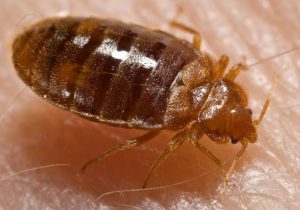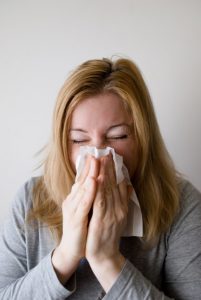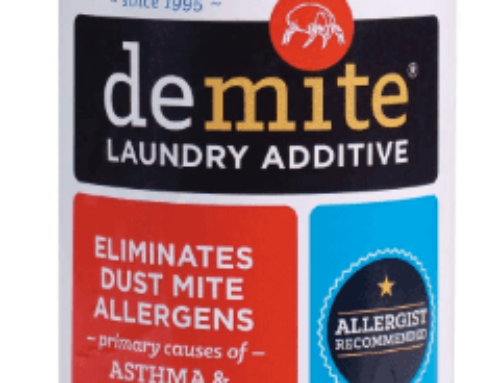Table of Contents
You know you’re not alone in the bedroom, but you can’t decide if it’s dust mites or bed bugs that are sharing your space. Regardless of what they are, the last thing you want is to have your house infested with bed bugs or dust mites.
These creatures cause harm in their own way and neither is pleasant for you and your family. But if you wish to end their stay in your home, it helps to tell them apart.
Understanding the nature of dust mites and bed bugs help you to zoom in on their breeding spots and take appropriate measures to contain, reduce or eliminate their presence in your home.
How Do Dust Mites & Bed Bugs Look Like?

Dust Mite

Bed Bug
Most people mistaken dust mite for bed bugs. Except that they both look hideous, there’s nothing in common in both house pests. You can’t actually see a dust mite with your bare eye unless you have a superhuman vision. An adult dust mite measures approximately 0.3 millimeters or 0.01 inches. That’s tinier than the dot on the ‘i’.
A dust mite is identified by its translucent exoskeleton, the lack of antennae, and eight legs. They look nothing like their cousin spider that belongs to the Arachnids family.
Meanwhile, you may spot bed bugs crawling over your skin, bed, or furniture. Bed bugs are considerably larger than dust mites, often the size of a seed. You know you have bed bugs when you spot tiny oval-shaped, flat creatures with six legs and a pair of antennae.
Placed side by side, it is impossible to mistake a dust mite for a bed bug.
What Do These House Pests Feed On?
When you’re aware of what dust mites and bed bugs feed on, bedtime will never be the same again. Dust mites depend on humans for food, but they don’t bite. Instead, dust mites fed on the dead skin cells that you shed daily.
Considering that an individual shed millions of skin cells a day, there’s no shortage of food supply to the dust mites in your home.
Bed bugs, however, have a nasty feeding habit. They thrive on sucking blood from humans and that’s how bed bug bites happen. Bed bugs are a nocturnal organism that will hunt for food when you’re asleep. So there’s a chance of you waking up with itchy bite scars on your skin. Also, there may be tell-tale blood marks on your mattress.
If you’re wondering why you don’t catch bed bugs biting on you, it’s because they inject an anticoagulant, which gives them ample time to feed without waking you up.
Where Do They Live?
You may have got the hint that both dust mites and bed bugs are sharing the same bedroom with you. While both have different feeding habits, humans are the primary source of food.
You’ll find dust mites growing on and in your mattress. Considering that an individual spends an average of 7 hours sleeping, the bed is where most of the skin cells are being shed. Technically, it’s an endless supply of food for dust mites. Also, dust mites thrive in dark and humid environment and that’s basically most households on the planet.
As for bed bugs, they are hiding not too far from dust mites. Bed bugs prefer cracks and crevices that are hidden from plain sight. Also, you may find bed bugs hiding beneath cupboards or upholsteries. Occasionally, you may spot their feces, and skins that gave away their hiding spot.
What Harm Could Dust Mites & Bed Bugs Cause?

Considering that bed bugs bites and dust mites don’t, you would have thought that bed bugs are the worse of the two. Bed bugs may cause itchy bites and red swollen spots on your skin. Often, bed bug bites heal by itself within 1-2 weeks.
However, the problems caused by dust mites are on a different level. While dust mite itself is pretty harmless, the fecal pellet triggered allergic reactions when inhaled through the respiratory system. The presence of dust mites explain symptoms like sneezing, coughing, teary eyes, itchy throats, and nasal congestion.
In some cases, severe dust mites allergy may lead to complications like asthma.
How Do You Eliminate Dust Mites And Bed Bugs?
I spent more than a year battling dust mites in my home as my son developed serious allergic symptoms to these microscopic pests. I’ve installed a HEPA air purifier, bought a HEPA vacuum cleaner, clean the beddings regularly, and use a natural dust mite spray.
It’s hard to pinpoint which deliver the killer blow to the dust mites, but I believe they all play a part in reducing the symptoms.
As for bed bugs, it’s also important to keep your home and bedroom clean and uncluttered. You will also need to seal cracks on bed and furniture that may hide bed bugs. Using diatomaceous earth may also help in destroying bed bugs.
Ultimately, you may have completely get rid of bed bugs but dust mites are a stubborn enemy. As long as you reduced dust mites to a minimum, the allergies will subside.
Do you have dust mites or bed bugs infestation in your house? How did you contain them? Share your experience in the comment below.
Related:
- Dust Mite Bites Symptoms – How Bad Can They Get
- Does Lysol Kill Dust Mites?
- Where Do Dust Mites Live (And How You’re Feeding Them Unknowingly)
- Where Do Dust Mites Come From?
- How To Know If You Have Dust Mites At Home




I’ve learned allot about bed bugs and dust mite. I am planing on buying a new mattress the I willI need to get a good cover . Thanks for the great information.
Thanks for checking out the article. Glad it helps.
Cheers,
Kenny
Thank you for helping me distinguish the difference between bed bugs and dust mites. Although I kind of got grossed out learning they eat my dead skin. haha. Thank you for the info!
Hi Meghan,
Glad that the article helps you.
Cheers,
Kenny